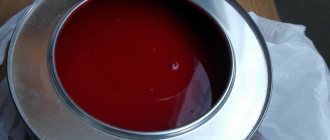Article navigation
How much corrector should I add? How to get purple correctly Using oil paint When using acrylic paint Watercolor Mixing gouache From food coloring How to get purple when mixing paints, gouache? How to make purple from acrylic paintsDifferent shades of purpleLight purple and soft purple from paints, gouacheDark purple from paint, gouacheLilac colorLilac colorWhat tools are neededHow to make purple from gel polish paintsUseful tipsWhat are the names of different shades of purpleGetting the colorOrdinary purpleLight purpleDark purpleHow to achieve the desired color?Theoretical informationUsing sirens brown color in design Information about violet color: how it affects humans Getting violetColor correction
How to get purple correctly
The basic rule for obtaining this shade is to mix red with blue. Moreover, under no circumstances should yellow be included in the palette. It will bring a dirty, brown tint that will ruin the whole job. Gouache and watercolor must be pure, without additional impurities. They should not contain inclusions of other tones. Let's take a closer look at obtaining new halftones in various ways.
Using oil paint
Beginning artists are wondering: how to get a purple tint using oil paints? What colors and proportions are needed? Oil paint has a paste-like consistency, which, after squeezing out of a tube, quickly dries and hardens. The coloring takes on a glossy appearance and a dense layer.
Read also: Gotu kola (trisanthus cochinchinensis)
Expert opinion
Zakharova Irina Yurievna
Cleaning professional with 15 years of experience. Our best expert.
Ask a Question
Dilute with a special solvent. To obtain the desired shade, you need to mix the components intensively. Purple color is obtained by mixing blue oil with red.
When using acrylic paint
The acrylic suspension has good hiding power and a dense elastic structure. The process of obtaining this shade with acrylic dyes is similar to the option described above with oil. To dilute the mixture, water or special solvents are used. When dry, a smooth surface is obtained. Acrylic is resistant to getting wet. The painted surface will not crack or lose its original appearance and will be pleasing to the eye for many years.
Watercolor
Watercolor is a more delicate, transparent substance. When working with it, you need to be very careful and not overdo it with adding thinner. To create a violet color, you need to mix blue with scarlet. Proportion: two to one. Sometimes a little white is added to smooth out the contrast.
Mixing gouache
When working with gouache, artists are faced with the fact that the color of lilac is often missing from the set. Therefore, you have to create a shade by mixing red and blue colors. A mixture of these two components must be prepared in a proportional ratio, like 2 to 1. Gouache is a dye with a matte structure; it is quite easy to obtain the necessary variation.
It is important to use clean brushes. After work, wash and dry them.
From food coloring
Food coloring makes culinary creations more vibrant and original. To get a purple color, it is enough to have a set of red and blue. Take blue dye and add scarlet to it, observing the ratio:
- Blue – 100%.
- Red – 50%.
See also
What is the weight of paint contained in 1 liter and its density, how to convert from kg to l
Features of working with watercolors, oil paints, gouache
Working with gouache is easier than with other types of paints.
This type of color is rich and deeply pigmented, so adjusting the shade of purple is not difficult. We must remember that when the gouache dries, it becomes a little lighter, so the desired shade must be made a little darker. Watercolor has a translucent texture. In this case, you can increase the “pallor” of the paint without white, using ordinary water. But in the drawing, watercolor does not look as bright as gouache. Oil paints are more difficult to work with; they have a special structure and high fluidity. The composition should be mixed especially carefully so that all layers are combined into a single whole. Artists also use other methods of mixing oil - overlaying tones, optical techniques. In the first case, the strokes are applied on top of each other, in the second, the paint is mixed directly on the canvas. Beginners should start working on creating original shades with gouache - the classes will be exciting and will appeal to children and adults!
How to make purple from acrylic paints
Purple color can be purchased when mixing acrylic paints. They are much more convenient and easier to interact with than oil ones.
Step-by-step instructions for creating purple from acrylic paints:
- Distribute the base blue on the palette.
- Include auxiliary red in small portions to achieve the desired result.
- Adjust the resulting tone with a white or black tint.
It is quite difficult to calculate the amount of acrylic, so the colors should be combined gradually, testing the finished result each time.
Different shades of purple
You can make new paint in different ways, there are many options. With simple steps you can get shades - from dark to light purple, lilac, violet, cold purple, etc. This is especially important for artists who use a rich color palette.
Light violet and soft violet from paints, gouache
Getting the right shade to perfection is difficult. It is usually obtained experimentally by making strokes on paper, adding components until the desired result is obtained. It is especially difficult for those who mix tones for tinting walls - they must act carefully. You cannot mix paints in large proportions and apply them directly to the canvas. Pre-testing is required.
You can get light shades of purple by combining pink and blue. The easiest way is to take ready-made pink gouache or watercolor, drop a couple of drops onto a plastic palette, and then add blue paint. There is a more difficult option when blue and pink are not available. Then they take red and blue paints, dilute them with white and get the corresponding tones. Then, when they are combined, a soft purple color emerges.
The most beautiful shades come out when using these paints:
- cobalt red;
- azure;
- ultramarine;
- phthalocyanine.
You need to create a muted purple color in a different way. This will require a cool red tone (such as alizarin). Black paint is introduced into it in small portions. After obtaining a rich purple color, it is greatly diluted with whitewash or ordinary white gouache. This will allow you to get different shades of purple, even pastel.
Dark purple color from paint, gouache
Artists use a special spatula - a palette knife - to mix tones. It allows you to mix the gouache perfectly without streaks or spots on the future drawing. A spatula is especially useful for combining bright purple flowers and dark shades.
The easiest way to create a rich color is to mix cool shades of blue and red. But if they have warmer reflections, there is a risk of getting a poor-quality result. The finished paint may have a brown or gray tint. In this case, introducing a small amount of black gouache will help correct the situation.
Mixing cool red and black will produce a purple color even without blue dye. The main thing is to use only deep black tones (black resin and others). Black should be introduced slowly, in very small portions. It absorbs red strongly and is required in minimal quantities.
To get the brightest purple tone, you can combine the colors cyan (blue) and magenta. When diluted with white, lighter shades will emerge. On the contrary, ready-made purple can be “thickened” by adding black gouache.
Purple colour
Designers, artists, decorators and even chefs love it very much. To get a lilac color, use a white palette or a regular white ceramic plate (so that there is no tone distortion). Masters often carry out such work on a white canvas.
Lilac is considered a cool shade, so it can also be achieved by mixing cool blue and red tones. Next, the color must be whitened until the required shade is produced. If the finished color glows pink or reddish, add more blue or a drop of black. The latter perfectly absorbs unnecessary redness.
Lilac color
Lilac is the color of violet, lavender, and dark lilac inflorescences. It is reminiscent of purple and lilac, but has a lot of red tones. Professionals have a way to get a real purple tint. To do this, the original red must have a minimum of orange reflection. Pale lilac will come out as a result of combining pink, white and ready-made purple flowers. This tone will resemble the shade of the evening sky. By introducing new portions of blue, white, pink and red colors, the following tones are obtained:
- operatic mauve;
- pink-lilac with gray;
- blue-purple.
In general, all purple tones are divided into categories “K” and “C”. In the first, red dominates, in the second, blue. Lavender-gray shade is obtained by introducing pink and black.
Getting lilac - instructions, rules
To make a lilac color, you need to prepare the paints in advance. Typically, artists prefer to work with gouache, although watercolors, acrylic colors, wall and ceiling (interior) paints can be used for mixing. Confectioners use food colorings, which also mix well and allow you to create real culinary “paintings.” It is best to combine colors on a special white palette, which will allow you to accurately assess the intensity and shade of lilac. If you don't have a palette, a white ceramic or plastic plate will do.
The easiest way to make lilacs is to take blue and red paints, combine them, and mix thoroughly. It is necessary to take a little more blue tone so as not to turn purple. But even the closeness of the finished paint to purple can be corrected. To do this, add a couple of drops of white to the resulting color - this allows you to “cool” the color and bring it closer to lilac.
What to do if the finished lilac has a pink or red tint? You can “calm” the color by adding black
It's great at absorbing redness, but it's important not to overdo it. Otherwise the tone will be very dark, gloomy
Professionals have their own secrets for developing unique shades - bright, saturated. To obtain a color that “goes” into blue, use ultramarine or Persian blue and crimson instead of standard gouache paints. There are other rules when working with paints:
- if you don’t like the resulting shade, you need to mix the tones again, using different proportions of colors;
- after receiving the mixture, you should carry out a test painting on a rough sheet, canvas, section of the wall - perhaps in practice the tone will look different;
- For work, you must use only absolutely clean brushes and a palette, otherwise the color will have a dirty reflection.
To obtain original shades of lilac, you can use turquoise, yellow and even green, but you must be careful with them. Usually the dosage is tiny, otherwise the paint will be hopelessly damaged.
Shades of lilac
Lilac is not a basic color, but even it has many tones, “popping” colors. By adding different pigments or lightening the paint, you can get up to 200 different shades - from pastel to dark. At the same time, the transition from one tone to another has a barely discernible edge, so it is very difficult to guess the proportions.
Only professional colorists and artists can distinguish similar shades. Here is an approximate classification of lilac tones:
- by brightness level – pale, light, medium, bright, dark;
- by warmth (depending on the amount of red color) - periwinkle (the coldest), wisteria (the warmest), orchid (medium);
- according to the dominant tone - pink-lilac, lavender, amethyst, blue-lilac, beige-lilac, gray-lilac, etc.
You can make an interesting lavender shade. To do this, add a drop of green to equal parts of blue and pink. If you combine ready-made lilac with a small proportion of gray, you get a metallic shade of this tone. A mixture of crimson and indigo with the addition of white gives the most delicate lilac color.
What tools are needed?
To work you will need the following tools:
- Palette. Preferably white, as a colored surface can distort the shades. Models made of plastic or materials with similar properties are best suited.
- The basic set of colors is red, blue, yellow, green, white and black.
- Tassels.
- A glass or small jar of water. The liquid must be changed periodically to prevent the brushes from clogging.
- Canvas draft. You can use it to check how well the smear will fit.
If you don’t have a palette, you can replace it with a glass, plate, bowl, special mixing bowl, or any other glass or plastic container.
It is important that all tools are clean and free of traces of previously used paints.
General information
What tools will you need?
To complete the work you will need the following tools:
- Palette - ideally it should be white, because a colored surface can distort shades. Ideally, models made of plastic or other materials with similar properties are suitable.
- The main set of colors is blue, red, green, yellow, black and white.
- Brushes.
- A glass or even a small jar of water. The liquid should be changed from time to time to prevent the brushes from becoming clogged.
- A rough canvas – you can use it to check how well a brushstroke can go.
If you don’t have a palette, you can replace it with a glass, plate, bowl, special mixing bowl, or any other plastic/glass container. It is important that all tools are clean and free of previously used paints.
Getting Color
To get different shades of purple, including lilac, you should mix red and blue paint. It is important to avoid yellow and all shades that contain it, as otherwise the result will be a dirty brown or gray undertone. When mixing, it is important to pay attention to the degree of saturation and purity of the blue and red colors - the characteristics of the final color will depend on this. If the set of paints contains pure purple, then it is better to use it to create shades. The resulting shades will be more saturated and less pale than those created by mixing blue and red.
- Simple purple
The standard purple color can be obtained by mixing red and blue in a ratio of 1 to 2. Then, from this base, you should create various shades, add white, black, pink, blue and other tones.
- Light purple
It will be much easier to get a light purple color by adding white to the base color. For the main color, white should be gradually mixed until the desired result is achieved, and the result should be periodically checked on the palette. The maximum ratio of white to base will be 1 to 5, since otherwise the main color may be lost.
If you want to slightly lighten the tone, you can dilute the paint with purple water. This helps keep it more natural and rich. It is worth considering the fact that mixing light colors is allowed only on a snow-white palette, because a painted or wooden surface will distort everything. It is not difficult to get a lilac color by mixing paints, and you can also make a light shade (thistle, wisteria and lilac) by mixing pink and blue.
You should take the first color as a basis, and then gradually introduce the second. Cooler shades of pink will produce pale tones of light purple, while warmer shades can add brightness. If you add a little red to the color, you get a nice amethyst light color. By adding blue you can achieve bright undertones with a berry tint.
- Dark purple
A darkened shade is obtained by mixing dark blue and bright red. The first color will absorb the warmth and richness of the second, resulting in a dull eggplant shade. It can be made even a little brighter by increasing the amount of red, but this will not completely change the situation. An unusual option for a dark purple color would be mixing red and black paint. The second should be added carefully, in small drops, as otherwise the tone will be dirty. The brighter dark purple color is made from a mixture of indigo, red and lilac. The saturation and tonality will depend on the proportion of colors, and you can also select it at your discretion.
How to adjust color
The purple color palette has an incredible number of shades, and each of them is used for decoration or painting. To obtain the required tone, mix paints, and also make corrections.
Its rules are:
- White will help lighten the tone and move it towards pastels. Watercolor and other paints can be diluted with a small amount of water. But you should not overdo it with the liquid, as otherwise you can ruin the paper or even get unsightly watery stains on the canvas.
- Adding black helps to darken the violet, but it must be introduced carefully as otherwise the mixture will completely lose color and become dirty to a dark grey. You can avoid this by adding dark indigo color.
- You can get lavender and delicate shades by turning gray to purple.
- To make the color richer, you can add a small amount of warm pink color. By changing the proportions and concentration, you can get grape, amethyst and other shades.
- Once again mix purple and red, and you can also get dark tones, for example, berry, wine and eggplant.
- Darken the purple a little by adding indigo or blue. As a result, you will get a cool and rich shade that is suitable for painting a night landscape.
- To get a bright plum color, you need to take a dark purple and dilute it with pure red.
- By adding a little blue tone to the purple, it can be shifted towards the blue without additional darkening. Lighten the resulting color with white if delicate lilac undertones are required.
Please note that when correcting color, be sure to ensure the cleanliness of the brushes and working surface. The smallest particles of other paint can ruin the entire work, clogging the paint with gray or brown specks. To avoid this, instruments should be washed thoroughly after each use.
How to make purple from gel polish paints
You can mix purple color from gel polish paints in the following way:
- Using a brush, drip a small amount of each shade (blue and red) onto the palette.
How to Mix Purple Color
- Use a plastic or wooden stick or brush to stir the mixture.
- If you are satisfied with the result, add the palette in similar proportions or continue combining shades to achieve the desired tone.
It is advisable to photograph or mark a successfully composed combination of proportions of colors so that in the future the color and ratio can be accurately reproduced.
There are nuances that must be taken into account so that the combination of gel polish paints can fully satisfy the needs of the artist:
- If the required shade is needed in sufficient quantities, it is recommended to mix colors with a reserve. This is because it is quite difficult to achieve the same match several times.
- It is the lightened shades that should be added to the dark ones, but not vice versa. Due to this, you can achieve a certain result with minimal consumption of materials.
- Under the influence of light, the resulting shade will begin to harden. To reapply the tone, it is recommended to keep it in an opaque, dark container.
Useful tips
When working with paints, it is useful to follow some rules:
- Always use a clean container to scoop up liquid. Otherwise, you can spoil the pure tone, and in the future it can turn out to be an unpredictable color.
- Mixing should be done gradually and carefully, since you can always add the ointment, but you won’t be able to remove it.
- The resulting shade must be checked not only on the palette, but also on the surface on which it will be applied.
In their work, confectioners often paint the mastic in the desired color. They do this using natural dyes.
What are the different shades of purple called?
There are about 200 varieties of purple (196 in the Pantone palette). Each of them is given a name - this is done for ease of orientation for artists, designers and specialists for whom understanding colors is important. The most common shades:
- purple;
- eggplant;
- indigo;
- lilac;
- violet;
- lavender;
- amethyst;
- lilac;
- thistle;
- pearl;
- fuchsia;
- royal purple;
- cuff;
- orchid;
- mov;
- crimson;
- grape;
- thundercloud;
- fig;
- plum;
- blackberry;
- cranberry;
- currant;
- orchid;
- iris;
- smoky lilac;
- peony;
- beet;
- phlox;
- heather;
- sparkling grapes.
In catalogs you can find more exotic shades of purple. Each of them is assigned a number in CMYK format (Cyan - blue, Magenta - magenta, Yellow - yellow, Key color - black), indicating the severity of certain tones. For simplicity, all shades are also given a simple name. Among them you can find quite unusual colors, such as “icy lavender”, “lilac snow” or “nostalgic rose”.
Shade table
For a more clear and visual examination of shades of purple, a table of mixing colors and the results obtained is provided.
| Bottom line | Mixable paints |
| Lilac | Blue + pink |
| Iris | Dark blue + bright red |
| Indigo | Blue + black |
| Purple | Red+blue+green |
| Lilac | Red + Blue + Green + White |
| Eggplant | Dark blue + scarlet |
| Bilberry | Purple + black |
| Lavender | Gray + purple |
| Plum | Purple + red |
| Grape | Blue + red |
| Amethyst | Lilac + red |
| Glycine | Blue + gray |
| Fuchsia | Red + indigo + lilac |
| Orchid | Red + blue + water |
| Blackberry | Purple + black |
| Violet | Purple + white |
This chart gives the base colors needed to create new shades. It should be noted that the previously stated ratios are rather arbitrary. You have to choose the right proportion yourself. After all, the result obtained depends on the initial quality of the suspension, its consistency, date of manufacture and expiration date. Create, fantasize and get new variations of the shade of purple.
Share link:
Getting the color
To get different shades of purple, you need to mix red paint with blue. However, you should avoid yellow and all shades containing it, otherwise the result will be a dirty brownish or gray undertone. When mixing, you should pay attention to the saturation and purity of red and blue - the characteristics of the final color depend on them.
If the set of paints already contains pure purple, then it is better to use it to create shades.
The resulting colors will be richer and less faded than those created by mixing red with blue.
Regular purple
The standard purple color is made by mixing blue and red in a 2:1 ratio. Then different shades are created from this base, adding black, white, pink, blue and other tones.
Light purple
The easiest way to achieve a light purple tone is by adding white to the base. White is gradually added to the main color until the desired result is achieved, periodically checking the result on the palette. The maximum ratio of white to base is 1:5, otherwise the main color may be lost.
If you need to lighten the tone slightly, you can dilute the purple paint with water. This helps keep it richer and more natural. It is worth considering that you can only mix light colors on a white palette, since a wooden or painted surface distorts them.
You can get unusual shades of light purple (thistle, lilac, wisteria) by mixing blue and pink. The first color is taken as a basis, then the second is gradually introduced. Cooler shades of pink produce pale tones of light purple, while warmer shades add brightness.
If you add a little red to the resulting lilac color, you will get a nice light amethyst color. By adding blue you can achieve bright berry undertones.
Dark purple
A darkened purple hue is created by mixing dark blue and bright red. The first color “absorbs” the warmth and richness of the second, resulting in a dull eggplant color. It can be made a little brighter by increasing the proportion of red, but this will not completely change the situation.
An unusual version of dark purple is created by mixing red paint with black. The second one is added quite carefully, in small droplets, otherwise the tone will become dirty.
A brighter dark purple comes from a mixture of red, indigo and lilac. Saturation and tonality depend on the proportion of colors; you can select it at your own discretion.
Lilac - description, similarities and differences with purple
The lilac shade in the general spectrum of tones symbolizes a bright future, nostalgia, sensuality, as well as mystery and mystery. It is rarely found in nature (mainly in lilac flowers), so it received a mystical definition from humans. Since ancient times it has been used for rituals. This color is often chosen by teenagers, which psychologists explain as follows: it is obtained by mixing blue and red, which denote masculinity and femininity.
For many, purple and lilac are the same thing. Both colors are considered cold, and in general are considered close “relatives”. Both of them are obtained by combining 2-3 colors and are called third-order colors. Also common between the tones is that they can be made from a mixture of blue and red paints. So what's the difference? The violet (violet) tone has more red, so even among cold shades it is warmer and brighter. Lilac contains a lot of blue, its second name is wisteria (wisteria).
Other features of lilac color:
- if there is an abundance in the interior, it can evoke depressive thoughts;
- It causes hidden anxiety and rejection in many people, but its connoisseurs are usually extraordinary individuals, very creative people;
- Only lilac has a true lilac tone, while plums are purple, forest bells are purple, grapes are dove-blue.
How to achieve the desired color?
Take red and blue colors and mix them in equal proportions 1:1. The result is a classic dark “low” purple. Now, to obtain a weakened strong violet, add white to it in the same volume. We have a basis for experimenting with lilac options.
To get a color that “goes” into blue, you can add ultramarine, and by thoroughly mixing the resulting composition with raspberry dye, you can create a magnificent Persian blue.
To get a bright lavender, take red or pink paint diluted with white and rub it with diluted blue - cyan. Add a gram of green to the resulting color - the lavender is ready! The intensity of the lavender will determine the amount of dye added to the white.
So, by experimenting and mixing paint after paint, regardless of what paints you currently use (acrylic, gouache, oil or watercolor), you can choose the color you need for bold design solutions.
In the video: obtaining purple color.
Color catalogs, which are often published on the websites of paint manufacturers, can tell you what colors to mix and in what proportions.
It remains to take into account some rules:
- Since the lilac color has many shades, when mixing colors to get a new one, you have to start all over again each time if you don’t like the range of the resulting shade.
- Mix red and blue again in the same proportion as originally, gradually adding more intense and white.
- Mix paints only on a clean palette surface and only with clean brushes.
- Since the shade of lilac depends on the original color of the main colors, you should definitely start mixing with them. How to mix? - very carefully.
- Be careful with the introduction of yellow, orange and black colors. Otherwise, you will learn not only how to get lilac, but also how to hopelessly ruin it.
How much corrector should I add?
Table for obtaining purple color
The corrector is able to neutralize the unwanted shade from the resulting color. To make the task easier, they use the so-called Oswald star. There are six colors indicated - three basic and three additional.
If the ends of the star are connected with diagonal lines, you get colors that neutralize each other. For example, the color violet can neutralize the basic colors: green, red and yellow.
To intensify the color, you need to add a corrector further down the color wheel.
In various areas of use, these correctors are also called mixtons.
Theoretical information
Purple, lilac, violet, lavender tones convey sensuality and tenderness. After all, in the outside world they can only be found on flowers or shrubs. Young people love these colors. They choose them as the main palette in the design of their room.
At first glance, getting them seems simple. You need to mix a couple of shades. But in reality, you have to select and add additional colors in order to better convey the richness and sensuality of color. Mechanical proportions are unlikely to help here. You must be able to pass paint through yourself.
To work you will need:
- palette;
- gouache, watercolor;
- brushes;
- vessel with water;
- a sheet of white paper for experiments.
Don’t forget to wash and dry your brushes before starting work. The base purple color consists of red and blue tones. Moreover, you need to take twice as much blue. Next, by mixing additional colors, light, dark, saturated or soft undertones are obtained.
Gouache and oil
How to get purple color when mixing paints? It is formed on the basis of violet. To get purple paint, you can mix red and blue. Since lilac is lighter, you will need to add white. You need to take about the same amount of them as the resulting purple paint. If the desired shade is even lighter, closer to lilac, more white will be needed.
Using gouache, you can immediately take purple paint. It should be taken into account that purple can be different - in sets and separately on sale there are paints “Violet K”, which has a more reddish tint, and “Violet C”, which has a slight blue tint. Therefore, you should carefully select the purple paint and, if necessary, adjust the shade by adding red or blue, and only then add white.
There is another algorithm for obtaining purple. In a bowl for mixing paints, you must first mix pink and blue colors, mixing blue and red paint in half with white paint. After that, you need to mix them with each other, and you get purple. Working with oil paints is almost completely the same as the method described above.
Using lilac color in design
The walls and ceilings in the rooms, painted in the colors of spring fragrant grapes, give the room a slight sprinkling of fabulousness. Even the smallest room becomes light and joyful! The main thing is to maintain balance: you shouldn’t paint everything the same lavender or purple – the variety of the palette allows you to show maximum imagination.
An excellent option is to have one wall accented with powerful plum or piercing eggplant, and the ceiling with the most delicate pale lilac. In this “situation”, lavender mixed with a warm, almost white cream or creamy color will suit the walls. This way we will not lose harmony, but will make the room visually more voluminous and interesting.
Pure snow-white color combined with any shade of faint amethyst or delicate wisteria is a great choice! White balances any emotions, and lilac colors are the same spiritual harmony. Having chosen the appropriate option, we begin the experiment of mixing paints.
Information about the color violet: how it affects humans
The color violet and its shades can evoke a special mood in people of all ages. The palette of this color symbolizes wisdom, calm and silence. According to experts, this tone can set a person up for a certain solemnity that he could not even suspect.
In addition, the purple tone often becomes a symbol of irritability when the emotional state changes. It is able to stimulate the function of the cardiovascular system. Psychologists say that people who regularly encounter these palette tones are less likely to suffer from colds and viral diseases.
The color overlay method is a great option for mixing
If you use this shade in the interior and know how to distribute it correctly, you can forget about all kinds of inflammatory diseases and severe pathologies.
Getting purple
To obtain purple, at the initial stage you need to combine blue and red in equal proportions on the palette. The resulting color palette may not always match the desired tone, so it needs to be modified. This can be done using the following manipulations:
- To get a lighter purple paint, you can add a little white.
- When working with a mixture of lilac and white paints, you can get purple. The intensity is adjusted by the amount of white.
- A mixture of pink and blue colors will help create a soft lilac palette.
- If a muted tone is needed, black is mixed with cool red.
- When working with watercolors, saturation is regulated not with the help of white, but with the amount of water.
It is worth remembering that gouache becomes a couple of shades lighter after drying, so you need to achieve a darker color.
How to get purple when mixing paints, gouache?
Of course, the lilac shade is very beautiful, and paints of similar colors are often used to design walls in the interior of a house. But, of course, in nature you can find a large number of plants that have a purple color. Among them, a huge number are occupied by vegetables, berries, and flowers. But this color does not belong to the primary, primary colors.
- Lilac, as well as lilac and other shades of violet, is considered a secondary color, because obtained by combining other colors.
- If you use gouache, then you should pay attention to the name of the purple color. There are 2 categories of this color - these are K and C. In the first case, the red hue is dominant, and in the color scheme, it is between red and violet. But in the second case, purple has a predominantly blue tint, and is between blue and violet in the color scheme.
Mixing colors
- Of course, there are also a large number of shades of purple, and therefore you need to add white carefully. The classic “recipe” for a lilac shade is considered to be a combination of red, blue and white in equal proportions.
- You can go the other way, if you have pink and blue colors, they also need to be mixed thoroughly and this way you will get the desired purple color. If you don’t have such shades, then you can separately bleach the red color until you get pink, and the blue color until you get blue.
If you use watercolors, then in this case you won’t need white, and ordinary water plays the role of a clarifier; the main thing is to change it more often for the purity and clarity of the drawing.
Color adjustment
We have already talked about how to get purple colors by mixing paints. If the shade is not the one you wanted, you can always correct it. To do this, you should use the following tips:
- The color palette can be lightened or, conversely, look brighter with the addition of white. From the resulting shade and the same amount of white you can achieve a pastel color.
- To create a rich dark tone, you need to add a little black to it.
- If you don’t know how to make lavender with a grayish tint, you can mix white and black and add the mixture to the main mass of blue and red.
For a successful outcome of the experiment, it is also worth remembering that the brushes need to be washed with each set, which will allow you to maintain pure shades and get a purple color.
lilac color with lilac color with lilac color with other colors How to get lilac How to get lilac how to get lilac To get different can be obtained through will get light it will turn out a pleasant shade get through
Color Mixing Chart
Today it is considered fashionable to use non-standard colors not only in clothing, but also to create modern paintings and drawings. Using different shades, you can convey the depth and precision of an image, and most often, many artists can achieve the desired result only by mixing other colors.
There are chromatic shades, which are placed side by side in a circle of color combinations, as well as achromatic ones - located far from each other or opposite, when mixed, a shade with a predominant gray tint is obtained. Of course, to get the expected result, you need to understand the color scheme and the correct proportions when mixing, but it is also important to use materials that have a similar chemical composition. This can dramatically change the result, or you may end up with a completely different color than you want.
In order for the result to be as accurate as possible, it is better to mix a small amount of paints, because... with large volumes, you may not be able to guess the proportions accurately. The table we offer greatly simplifies the task of finding the right shade; it is used in various areas of life.
Color Mixing Chart
Thanks to the knowledge of proper color mixing, you can create real masterpieces. Good luck with your creativity.











